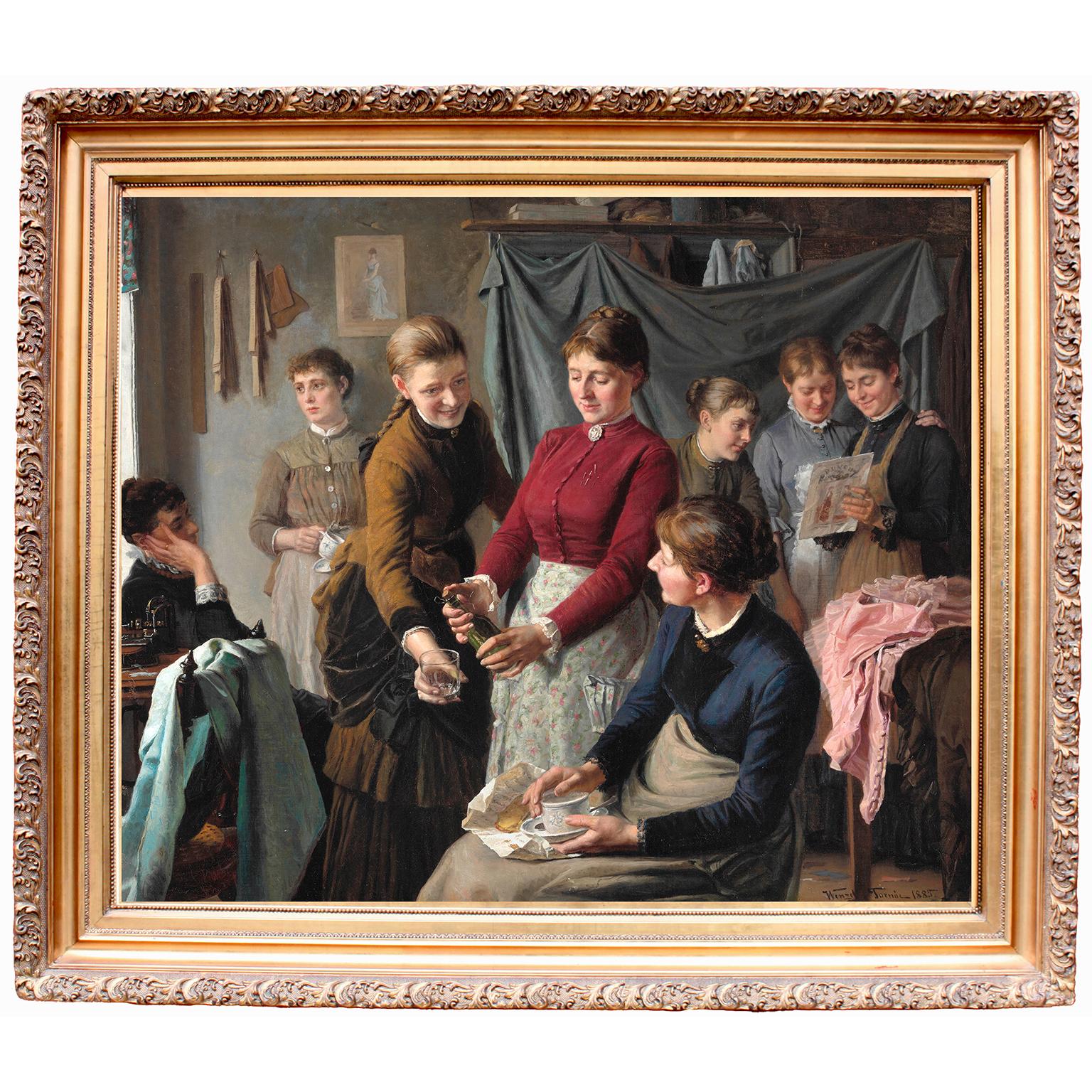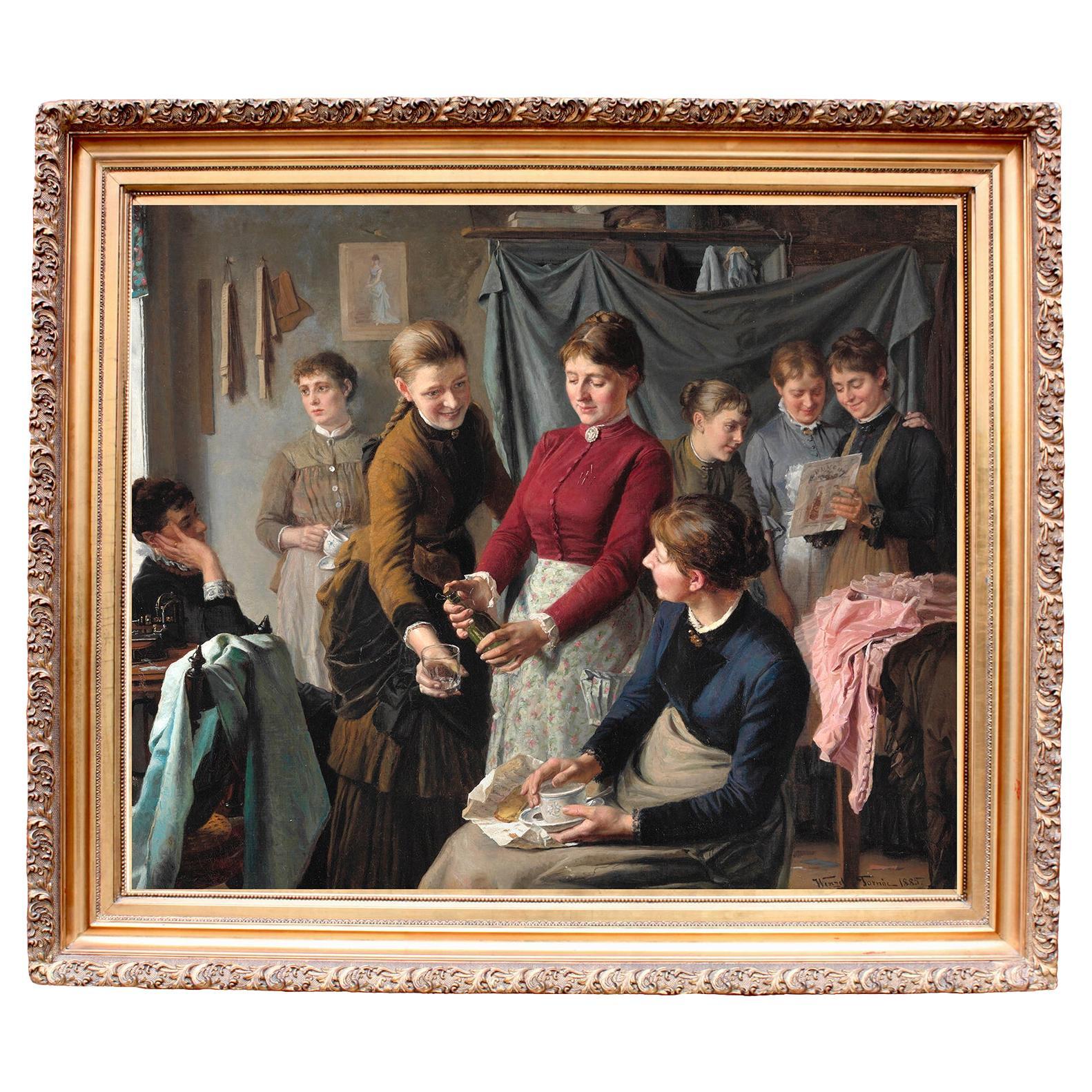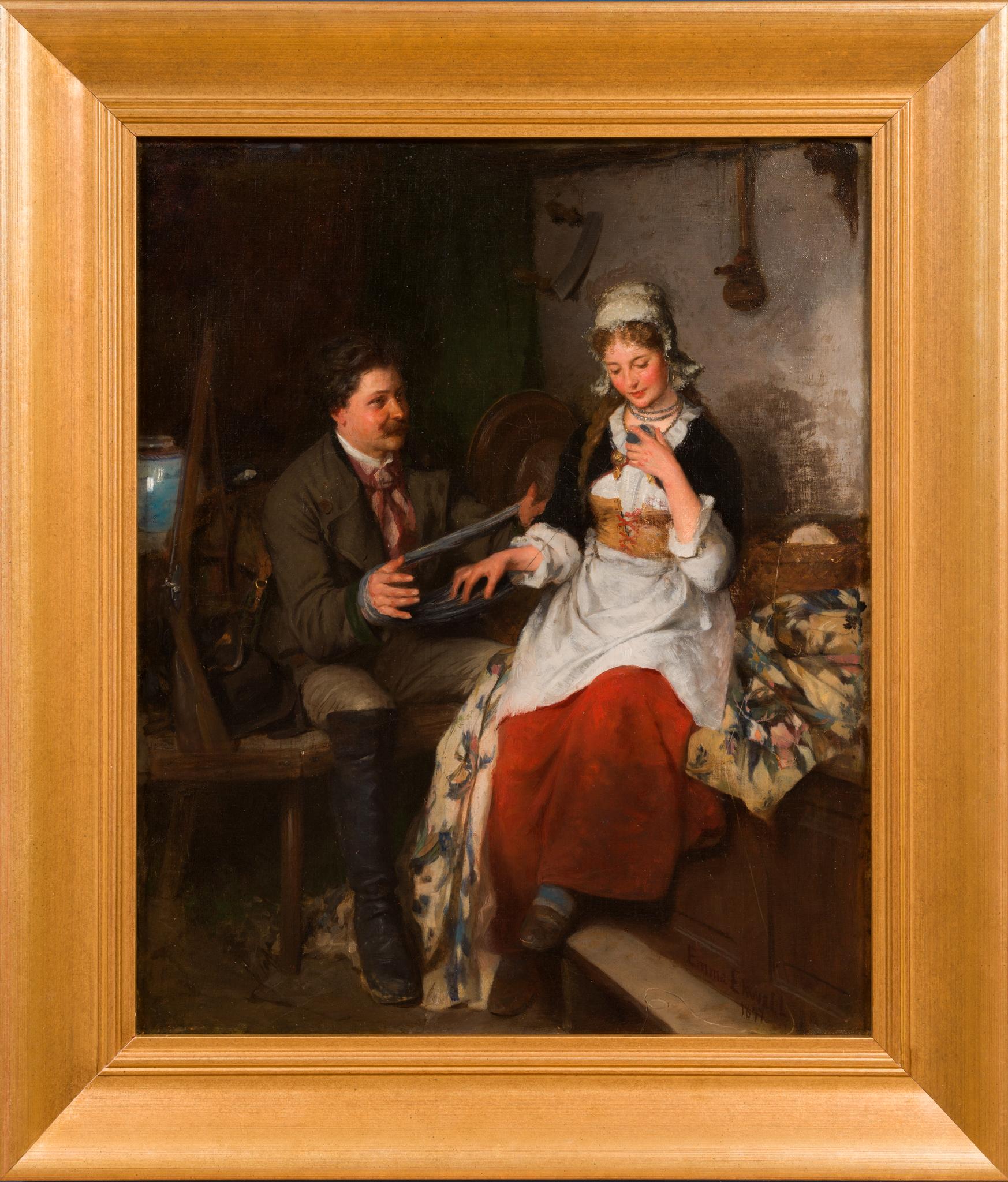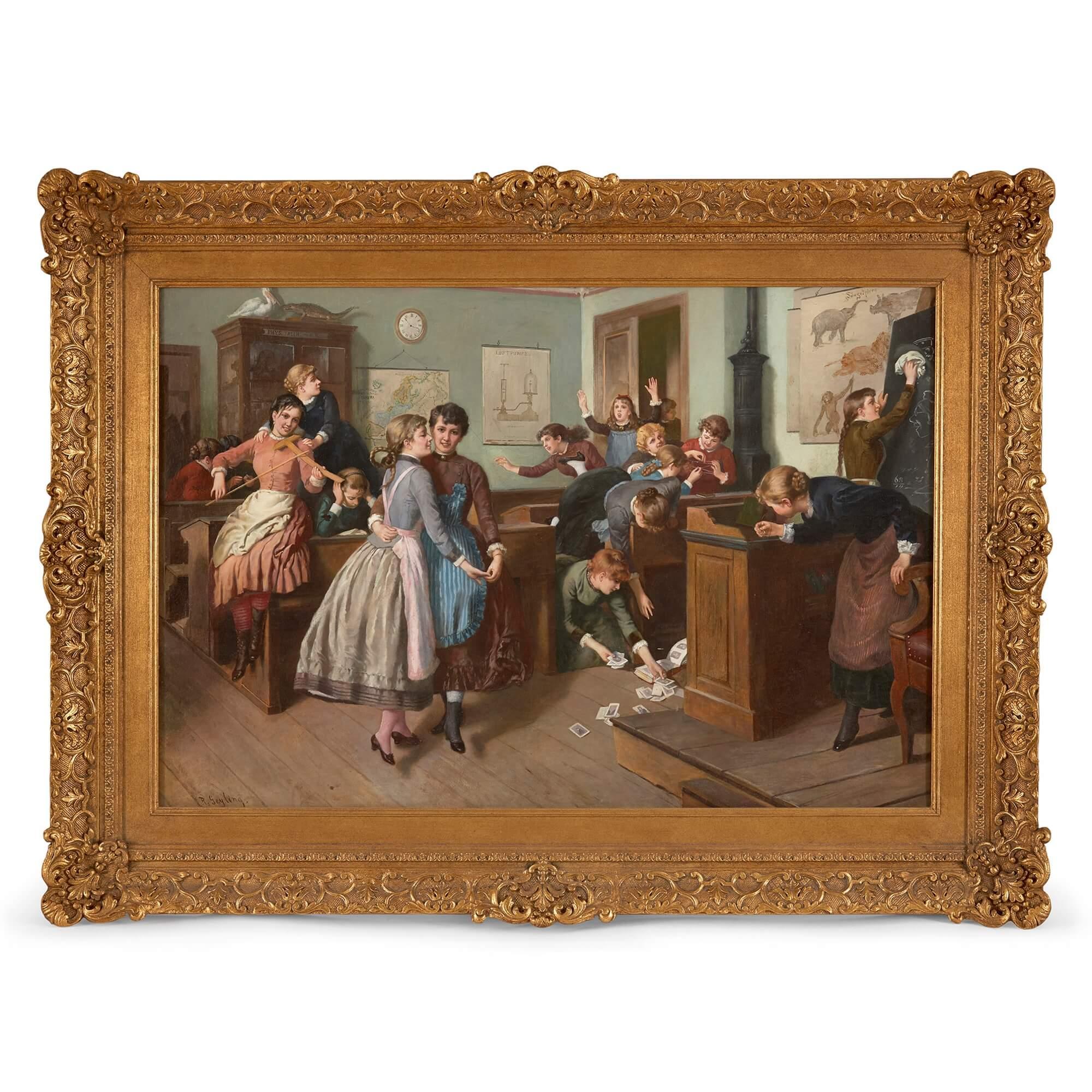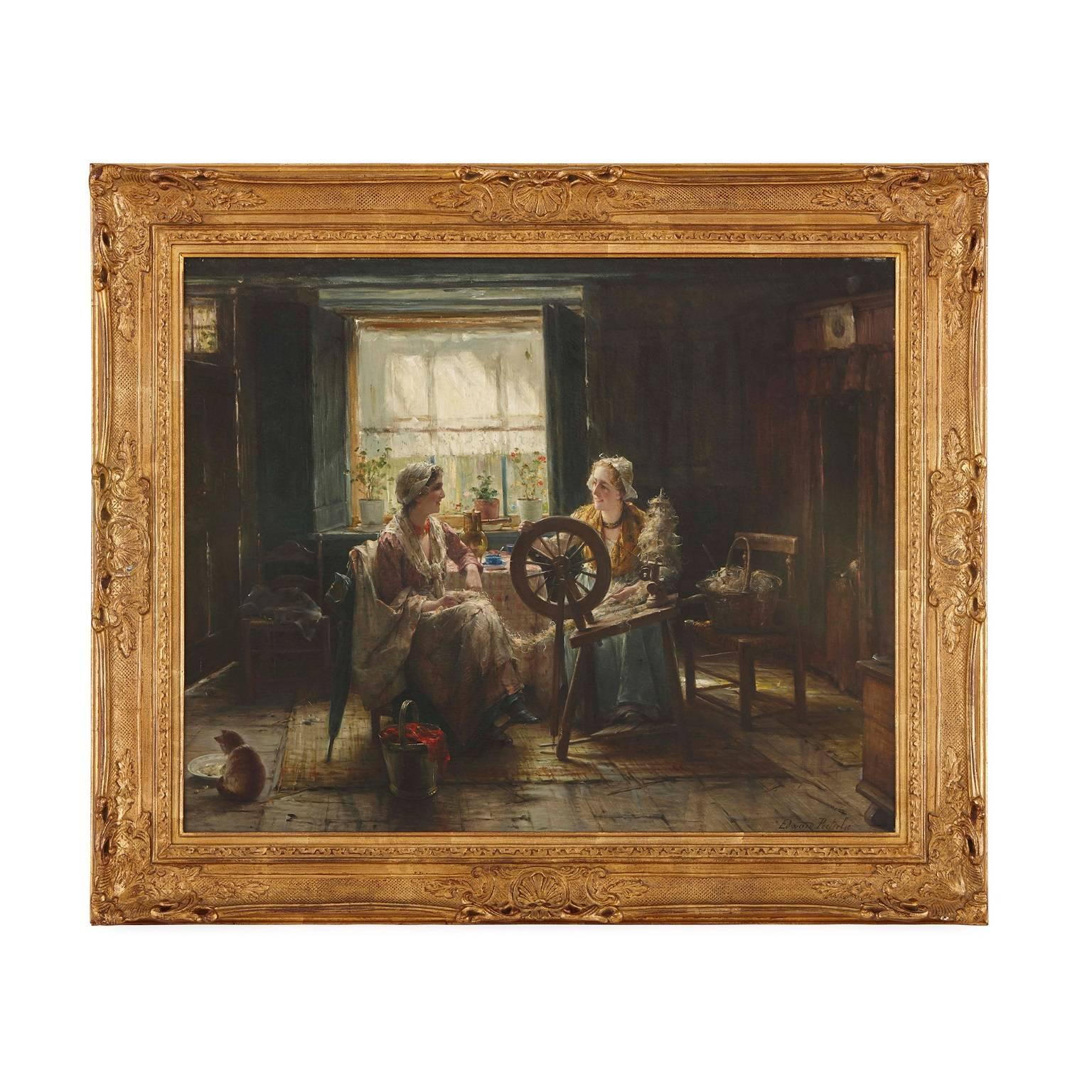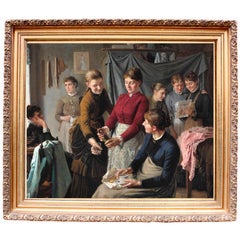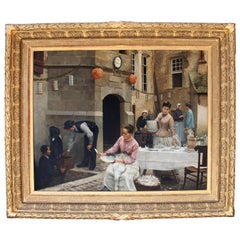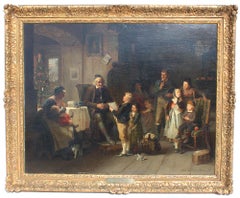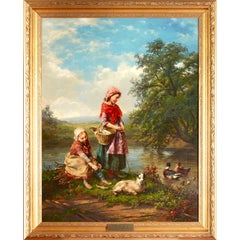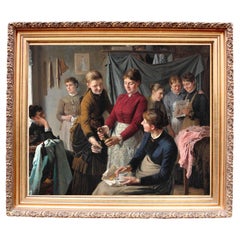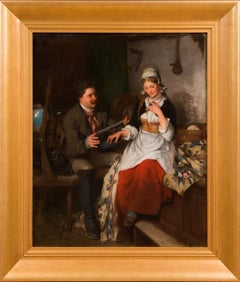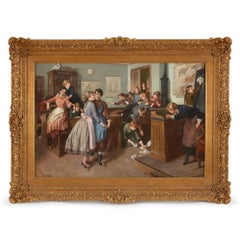Items Similar to A Very Fine Danish 19th Century Oil on Canvas "The Sewing Room" (Systue)
Video Loading
Want more images or videos?
Request additional images or videos from the seller
1 of 22
Wenzel Ulrik Tornøe (Danish, 1844-1907) A Very Fine Danish 19th Century Oil on Canvas "The Sewing Room" (Systue)Circa: Denmark, 1885
Circa: Denmark, 1885
$174,500
£131,775.43
€150,870.73
CA$246,439.61
A$269,053.07
CHF 141,053.52
MX$3,267,753.12
NOK 1,761,528.76
SEK 1,663,352.86
DKK 1,126,089.33
About the Item
Wenzel Ulrik Tornøe (Danish, 1844-1907) A very fine and large oil on canvas titled "Systue" ("The Sewing Room"). The finely executed artwork depicting the interior of a sewing room with eight dressmakers taking their lunch break; one opening a bottle of wine, another holding a glass ready for the pour, the seated center one holding a cup of tea with a semi-wrapped biscuit, one leaning against the back wall, another resting by a table and the other standing three maidens sharing catalogue page. Tornøe capture of the face expressions of exhaustion on the young seamstress’, as well as the details in the background and the efficacy of painting the transparent glass on they young girl’s hand are all truly exceptional, making this painting probably one of Tornø’s best artworks. Signed and dated: Wenzel Tornøe, 1885. Circa: Denmark, 1885.
Exhibited: Charlottenborg 1885 no. 404.
Wenzel Ulrik Tornøe (1844-1907) was born on September 9, 1844 in Svendborg Denmark, he was the son of Jens Wenzel Tornøe and Eleonore Jacobine Lacoppidan. On July 18th 1876 he married the artist Karen Elisabeth Blumer, daughter of the grocer Samuel Blumer and Bolette Marie Abigael Wendelboe. Tornøe is perhaps one of the most well known exhibited Charlottenborg Palace artists of that period. He was known for his poignant and anecdotal portraiture and genre pieces. Having studied under Carl H. Bloch (whose is considered the finest religious, genre and historical painter of his time), Tornøe surpassed many his peers in skill, technique and style. His works have sold at many prestigious auction houses around the world, including Sotheby’s, Christie's and many other works adorn the walls of private collections, museums, and European castles.
Education:
1860-1865 - Royal Danish Academy of Art
1871-1873 - Studied in Rome
1878-1879 - Holland, Belgium, Paris and Italy
1886-87 - Studied in Rome
Travels:
1871-73 - Rome
1878-79 - Holland, Belgium, Paris and Northern Italy
1886-87 - Rome
Exhibits:
1865-1997 - Charlottenborg Palace, DK
1882, 1942 - National Art Association Exhibit
1883, 1888 - Nordic Exhibit
1895 - Nordic Art Exhibit in Lubeck
1893 - World Exhibit in Chicago
1901 - Town Hall Exhibit in Copenhagen
1980 - Randers Art Museum Exhibit
1980’s - “in memory of…” National Art Exhibition
Awards:
1864 - Awarded silver medal at the Royal Danish Academy of Art
1902 - Serdin Hansens Prize
Wenzel Ulrik Tornøe (1844-1907) Artworks in Museums:
Statens Museum for Kunst - Copenhagen, Denmark - "At the China Repairer's" - Circa: 1891.
Randers Museum of Art - Randers, Denmark - "Syerske Pinsemorgen" (Sewing Pentecost morning) - Circa: 1882.
Canvas Height: 35 1/2 inches (90.2 cm)
Canvas Width: 42 1/4 inches (107.3 cm)
Frame Height: 44 3/4 inches (113.7 cm)
Frame Width: 51 3/4 inches (131.5 cm)
Frame Depth: 4 inches (10.2 cm)
Notes: A truly stunning artwork in overall fine stable condition with some age craquelure. Original canvas with vibrant colors and fine attention to detail. See report on repairs and view all images. Frame in good condition with some restorations.
- Creator:Wenzel Ulrik Tornøe (Danish, 1844-1907) (1844 - 1907, Danish)
- Creation Year:Circa: Denmark, 1885
- Dimensions:Height: 44.75 in (113.67 cm)Width: 51.75 in (131.45 cm)Depth: 4 in (10.16 cm)
- Medium:
- Movement & Style:
- Period:
- Condition:Two minor repairs/patches on reverse (see photo). A few small holes in the canvas at the lower left corner & upper right corner (see photo ). Few small insignificant peelings, primarily at the lower & the left edge. Areas thin paint layer, retouches.
- Gallery Location:LA, CA
- Reference Number:Seller: Ref.: A2676 - Lot 114561stDibs: LU2755214738242
About the Seller
No Reviews Yet
Vetted Professional Seller
Every seller passes strict standards for authenticity and reliability
1stDibs seller since 2024
- ShippingRetrieving quote...Shipping from: LA, CA
- Return Policy
Authenticity Guarantee
In the unlikely event there’s an issue with an item’s authenticity, contact us within 1 year for a full refund. DetailsMoney-Back Guarantee
If your item is not as described, is damaged in transit, or does not arrive, contact us within 7 days for a full refund. Details24-Hour Cancellation
You have a 24-hour grace period in which to reconsider your purchase, with no questions asked.Vetted Professional Sellers
Our world-class sellers must adhere to strict standards for service and quality, maintaining the integrity of our listings.Price-Match Guarantee
If you find that a seller listed the same item for a lower price elsewhere, we’ll match it.Trusted Global Delivery
Our best-in-class carrier network provides specialized shipping options worldwide, including custom delivery.More From This Seller
View AllA Very Fine Danish 19th Century Oil on Canvas "The Sewing Room" (Systue)
Located in LA, CA
Wenzel Ulrik Tornøe (Danish, 1844-1907) A very fine and large oil on canvas titled "Systue" ("The Sewing Room"). The finely executed artwork depicting the interior of a sewing room w...
Category
19th Century Academic Figurative Paintings
Materials
Oil
Georges-Marie-Julien Girardo (French 1856-1914) Oil on Canvas "A Wedding Party"
Located in LA, CA
Georges-Marie-Julien Girardot (French, b. Besançon 1856 - d. Paris, 1914) "Avant le mariage" (Before the Wedding) A Palatial and Impressive French 19th Century Oil on Canvas depictin...
Category
19th Century Academic Figurative Paintings
Materials
Oil
A Fine & Large 19th Century Oil on Canvas "New Year's Day at The Grandfather's"
Located in LA, CA
Friedrich Ortlieb (German, 1839-1909) A fine and large oil on canvas titled "New Year's Day at The grandfather's". The joyful indoor family scene depicting a Christmas and new year's...
Category
19th Century Academic Figurative Paintings
Materials
Oil
A Fine and Charming 19th Century Oil Canvas "Children Walking the Baby Goat"
Located in LA, CA
Henry Joseph Campotosto (Belgium, 1833-1910) A Very Fine Oil on Canvas "Walking the Baby Goat", depicting two young dutch girls by the grassy shore of a river bank, one standing holding a wicker basket and a leash to a resting baby goat, the youngest sitting next to her on a pile of branches tucking her pants, a pair of ducks and ducklings swimming by the tree lined river; within a later giltwood carved frame. Signed (l/r): Campotosto Henry. Circa: Brussels, 1870.
Note: The artist is also known as Henri Campotosto
Henry or Henri Campotosto was born in Brussels in 1833. He studied in Brussels at the Royal Academy des Beaux-Arts and painted some artworks with Eugène Verboeckhoven (Belgium, 1798-1881). He received a 1st Class Medal at the Academy of Brussels and an honorable mention at the Paris Exhibition of 1860. In 1871 he moved to London with his family and remained there for life. He exhibited his work at the Royal Academy Exhibition until 1874 and at the Suffolk Street Gallery from 1878. In 1880 he took part in the Berlin Academy Exhibition. His daughter Octavia also became a painter, visited Italy, and showed her paintings at the Royal Academy from 1871 to 1874. Henri Campotosto died in London in 1910.
High Sales:
Christie's New York - Property from an American Collection, "The Bird's Nest" - Lot 247 on October 22, 2008, Sold for $37,500
Bonhams London - 19th Century European, Victorian and British Impressionist Art on 28 September 2016 - Lot 33 "Gathering flowers" Sold for £25,000 ($33,750 USD)
Museums:
The British Museum - Print of two girls and a lamb and print of two girls by a river bank
Literature
• E. Benezit Dictionnaire des Peintres, Sculpteurs, Dessinateurs, et Graveurs by Librairie Gründ - 1976 Edition - Volume 2, Page 488.
• Maurice W...
Category
19th Century Academic Figurative Paintings
Materials
Oil
A Fine French 19th Century Oil on Canvas 'A Young Girl Holding a Bird's Nest'
By Charles Joshua Chaplin
Located in LA, CA
Charles Joshua Chaplin (French, 1825-1891) 'The Bird's Nest' A very fine and charming Rococo revival style oil on canvas depicting a young girl, dressed in 18th century costume and resting by a river bank, holding a bird's nest and one of the tiny eggs. Her bonnet resting to her side and a wicker basket full of hand-picked flowers by her feet; within a later giltwood carved frame. Signed: ChChaplin (lower left). Circa: 1870-1880.
Canvas Height: 31 1/2 inches (80 cm)
Canvas Width: 17 15/16 inches (45.5 cm)
Frame Height: 38 5/8 inches (98 cm)
Frame Width: 24 3/4 inches (63 cm)
Frame Depth: 2 3/8 inches (6 cm)
Charles Joshua Chaplin (8 June 1825 – 30 January 1891) was a French painter and printmaker who painted both landscapes and portraits. He worked in techniques such as pastels, lithography, watercolor, chalk, oil painting and etching. He was best known for his elegant portraits of young women.
Chaplin was born on 8 June 1825 in Les Andelys, Eure, France. His mother, Olympia Adelle Moisy, was French, whereas his father, John Chaplin, was an art broker from England. Charles Chaplin spent his whole life in France, becoming a naturalized citizen in 1886. He studied at the École des Beaux-Arts in Paris from 1840, and he took private lessons in the studio of Michel Martin Drolling, whose apprentices included Paul Baudry, Jules Breton and Jean-Jacques Henner. Later he also taught at the École des Beaux-Arts.
In 1845, he entered the Paris Salon, the official art exhibition of the Académie des Beaux-Arts, as a portrait and landscape painter with the painting Portrait of the Artist's Mother. Chaplin conducted art classes specifically for women at his studio, including Marie Joséphine Nicolas. The American artist Mary Cassatt, the French artist Louise Abbéma and the English artist Louise Jopling were among Chaplin's students. His son Arthur Chaplin was also a painter.
Early Work:
Chaplin made his debut at the Salon with portraits, but he also painted landscapes, particularly the countryside of Auvergne. His early works, from 1848 to 1851, were painted in a manner characterized by an interest in realism, a style established in the French Second Republic, that had the motto Liberté, égalité, fraternité, and was ruled for three years by the republican government of France from the 1848 Revolution until the 1851 coup by Louis-Napoléon Bonaparte. Realism was an artistic movement that began in France in the 1850s, after the 1848 Revolution. From the late 18th century Romanticism dominated French art and literature but was spurned by Realists, who revolted against the display of the emotions of the Romantic movement, seeking to depict real and characteristic contemporary individuals and situations with truth and accuracy.
Chaplin painted many works in his early days, including floral studies that were displayed at the Salon de las Flores. Later, in the late 1850s, he abandoned naturalism, his earlier style, exchanging it for a more graceful, elegant and supple technique that brought him a certain notoriety in France during his time as a portrait painter; as such he embraced the idyllic and voluptuous and fashionable style of the prominent French painter, François Boucher (1703–1770).
He also embraced the tradition of the great English portraitists and developed his very own style of painting but was inspired by the British painters Joshua Reynolds and Thomas Gainsborough. He used to engrave the works of the Dutch artist Pieter Paul Rubens and gained further influence from his work.
Later Work:
Gradually the muddy colours used by Chaplin transformed into white, grey and pink, depicting his models with an opalescent, mother-of-pearl complexion by applying a subtle palette of rosy flesh tones and light greys. After painting portraits and trying his skills on ornamental painting, Chaplin took up genre painting in the 1850s. His favourite subjects are the feminine grace of a young woman's everyday life. He portrays women in several poses: resting; grooming; singing; and reading. He captures them with lightness and carelessness and accentuates the decorative elements of the composition.
Empress Eugénie, the wife of Napoleon III and an admirer of the "Pompadour style", rapidly fell under the enchantment of the painter's neo-Rococo works. Chaplin was among Napoleon III and Empress Eugénie's favourite court artists. In 1859, when his portrait of Aurora was banned by the judges of the Salon as "too erotically suggestive", Napoléon III defended Chaplin and overturned the disqualification order. He was similarly valued as an interior decorator and was appointed to remodel the decor of Empress Eugénie's rooms.
His sensual portraits of women and young girls, often with models posed erotically in hazy surroundings and frequently wearing transparent clothing, attracted the interest of the high society and aristocracy of Paris during the French Third Republic (1870–1940) guaranteeing his success and wealth. He was one of the most popular painters of his time, but nowadays his work is almost unknown, in spite of the fact that his works hang in many major museums around the world.
He employed his Rococo style for his mythological scenes and genre scenes paintings. His genre pictures formed a significant part of his work. In 1861, working as a decorative painter. Chaplin painted the doors and several glass panels above them of the Salon des Fleurs in the Tuileries Palace. The Palace was gutted by fire in 1871 and its ruins swiftly demolished.[9] He also undertook decorating work in the Salon de l’Hémicycle of the Palais de l’Elysée.
Honours and awards:
As a member of the Académie royale de peinture et de sculpture, Chaplin exhibited his paintings at the Paris Salon, the official exhibition venue of members' work. He began exhibiting his paintings at the French Artists' Salon in 1845 and was represented there habitually each year. These exhibitions made him one of France's most famous portrait artists. Commencing in 1847, his work was exhibited regularly at the Royal Academy in London.
During his lifetime, he received acclamation for his artistic talents by the award of several medals: a third class medal in 1851; a second class medal the following year; and an Honour Medal...
Category
19th Century Academic Figurative Paintings
Materials
Oil
A Fine French 19th Century Oil on Board "A Standing Beauty with Spring Roses"
Located in LA, CA
A very fine French 19th century oil on board titled "A Standing Beauty with Spring Roses" by Charles Baptiste Schreiber (French, 1845-1903)...
Category
Late 19th Century Academic Figurative Paintings
Materials
Wood, Oil
You May Also Like
Wenzel Ulrik Tornøe Danish 19th Century Oil on Canvas "The Sewing Room" (Systue)
Located in Los Angeles, CA
Wenzel Ulrik Tornøe (Danish, 1844-1907) A very fine and large oil on canvas titled "Systue" ("The Sewing Room"). The finely executed artwork depicting the interior of a sewing room w...
Category
Antique 19th Century Danish Beaux Arts Paintings
Materials
Canvas, Giltwood
The Wool Winder (1877) by Swedish Female Artist Emma Ekwall
Located in Stockholm, SE
In The Wool Winder, Emma Ekwall captures a moment of quiet domestic intimacy between a young woman and a man as they wind wool together—she with focused care, he with gentle attentiv...
Category
1870s Realist Figurative Paintings
Materials
Canvas, Oil
Austrian genre painting of children in a classroom by Rudolf Geyling
By Rudolf Geyling
Located in London, GB
Austrian genre painting of children in a classroom by Rudolf Geyling
Austrian, late 19th Century
Frame: Height 94cm, width 126cm, depth 8cm
Canvas: Height 75cm, width 101cm, depth 2c...
Category
Late 19th Century Figurative Paintings
Materials
Canvas, Oil
Portrait of a Lady Sewing - British 19th century art Newlyn School oil painting
By Walter Langley
Located in Hagley, England
This beautiful late 19th century portrait oil painting is attributed to circle of Walter Langley. It has the hallmarks of the Newlyn School of artists such as the subject matter, com...
Category
1890s Realist Portrait Paintings
Materials
Oil
'Spinning the Wool', 19th Century Flemish oil painting of two ladies
By Edward Antoon Portielje
Located in London, GB
This fine antique oil painting depicts two ladies seated in a 19th Century style interior. In front of the woman on the right is an antique wool spinner; the woman pauses her work at...
Category
19th Century Naturalistic Interior Paintings
Materials
Canvas, Oil
Cornish Family in an Interior - British 1912 Newlyn School art oil painting
By Harold Harvey
Located in Hagley, England
This superb British figurative interior oil painting is by noted Newlyn school artist Harold Harvey. Painted circa 1912 the composition is a Cornish family, bathed in golden light, s...
Category
1910s Realist Interior Paintings
Materials
Oil
Harold HarveyCornish Family in an Interior - British 1912 Newlyn School art oil painting, Circa 1912
$44,087 Sale Price
20% Off
More Ways To Browse
Denmark Antique
Sothebys Antique
Danish Oil Painting
Antique Kunst
19th Century Oil Paintings Religious
Antique Danish Painting
Danish Paintings Of The 19th Century
18th Century Italian Religious Paintings
1907 Frames
Danish Fine Art
Danish Painting 19th Century
Antique Dressmaker
Don Johns
Dzemma Skulme
Framed Carpet Art
Glasgow Boys
Gossip Painting
Haitian Oil Painting
